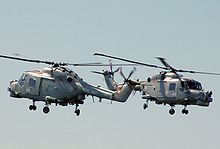Industry Aerospace Products Rotary-wing aircraft Founded 1961 | Fate Merged/Acquired | |
 | ||
Predecessor Westland AircraftBristol Aeroplane CompanyFaireySaunders-Roe Successor AgustaWestlandLeonardo-Finmeccanica Website www.agustawestland.com/index.html | ||
Westland scout helicopter at flugausstellung hermeskeil
Westland Helicopters was a British aerospace company. Originally Westland Aircraft, the company focused on helicopters after the Second World War. It was amalgamated with several other British firms in 1960 and 1961. In 2001, it merged with Italian helicopter manufacturer Agusta to form AgustaWestland (in turn merged into Leonardo-Finmeccanica since 2016).
Contents
- Westland scout helicopter at flugausstellung hermeskeil
- Post war refocusing
- Forced merger
- Decline
- Turnaround
- Helicopters
- Hovercraft
- Rockets and missiles
- UAVs and drones
- Precision gears
- References
Post-war refocusing
Westland Aircraft was founded in 1935 when Petters Limited split its aircraft manufacturing from its aircraft engine concerns. During the Second World War the company produced military aircraft including the Lysander, the Whirlwind and the Welkin.
After the war the company began to build helicopters under a licensing agreement with Sikorsky. From the mid-1950s the company came to increasingly concentrate on helicopters, eventually to the exclusion of other types. Production started with the Sikorsky S-51, which became the Westland Dragonfly, flying for the first time in 1948, and entering service with the Royal Navy and Royal Air Force in 1953. Westland developed an improved version the Widgeon, which was not a great success. Success with the Dragonfly was repeated with the Sikorsky S-55 which became the Whirlwind, and a re-engined Sikorsky S-58 in both turboshaft and turbine engine powered designs as the Wessex.
Forced merger
The chairmanship of Eric Mensforth from 1953–1968 marked the start of the transition, which was aided by the government when in 1959–1961 they forced the merger of the 20 or so aviation firms into three groups, British Aircraft Corporation and Hawker Siddeley Group took over fixed-wing designs, while the helicopter divisions of Bristol, Fairey and Saunders-Roe (with their hovercraft) were merged with Westland to form Westland Helicopters in 1961.
Westland inherited the Saro Skeeter helicopter, a development of the Cierva W.14 Skeeter and the Fairey Rotodyne compound gyroplane design. They continued to develop the latter, terminating their own Westland Westminster large transport design.
The company continued to produce other aircraft under licence from Sikorsky (Sea King) and Bell (Sioux). They also produced their own designs; the Westland Scout and its naval variant the Westland Wasp from the P.531 which found favour with the Army Air Corps and Fleet Air Arm respectively.
In the late 1960s, the company began a collaboration with Aérospatiale to design three new helicopters, the Aérospatiale Puma, Aérospatiale Gazelle and Westland Lynx, with the last being a Westland design.
Through Saunders-Roe, Westland became first a part owner then, from 1970, the whole owner of the British Hovercraft Corporation, subsequently trading as Westland Aerospace. Most designs were Saunders-Roe or Saunders-Roe derivatives.
For many years Westland owned the main London heliport at Battersea.
Decline
Despite good support from the British establishment, the company gradually fell into unprofitability. Sikorsky approached with a bail-out deal in 1985 that split the cabinet and led to the resignation of Defence Secretary Michael Heseltine in January 1986 over the fate of Britain's sole helicopter manufacturer. The split, which became known as the Westland affair, was over whether to push the company into a European deal or accept the US company's offer. Eventually, the link with Sikorsky was accepted.
Turnaround
In the 1990s, the company returned to profitability and grew as a result of several major contracts from the UK Ministry of Defence for EH101 Merlin helicopters and for 67 licence-built Boeing AH-64 Apache attack helicopters, designated the WAH-64 and entering full operational service in 2005.
GKN bought into Westland in 1988, acquiring a stake owned by Hanson plc. They soon acquired the shares owned by Fiat which gave them absolute control. In 1994, Westland became a wholly owned subsidiary of GKN. It was merged with Finmeccanica's Agusta helicopter division in 2001. The newly merged company AgustaWestland still maintains the plant at Yeovil. In 2004, Finmeccanica S.p.A. acquired GKN's share in the joint venture.
The former Westland site at the now unused airfield in Weston-super-Mare houses The Helicopter Museum featuring a number of examples of Westland aircraft.
